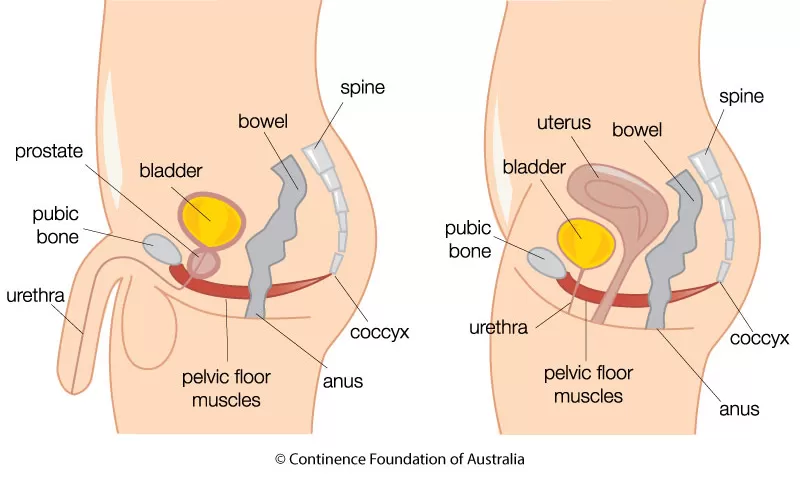ABOUT THE PELVIC FLOOR
What are pelvic floor muscles?
The pelvic floor muscles give you the ability to control the release of urine (wee), faeces (poo) and flatus (wind) and to delay emptying until it is convenient.
When you contract the pelvic floor muscles, they lift the internal organs of the pelvis and tighten the openings of the vagina, anus and urethra. Relaxing the pelvic floor allows passage of urine and faeces.
This function is especially important if your urethral or anal sphincters (muscles) do not work normally, as may be the case after giving birth or after prostate surgery.
Pelvic floor muscles are also important for sexual function in both men and women. In men, it is important for erectile function and ejaculation. In women, voluntary contractions (squeezing) of the pelvic floor contribute to sexual sensation and arousal.
The pelvic floor muscles in women also provide support for the baby during pregnancy and need to be relaxed during the birthing process.
Anatomy of the pelvis
The pelvic floor muscles form the base of the group of muscles commonly called the ‘core’. These muscles work with the deep abdominal (tummy) and back muscles and the diaphragm (breathing muscle) to support the spine and control the pressure inside the abdomen.
The floor of the pelvis is made up of layers of muscle and other tissue. These layers stretch like a hammock from the pubic bone at the front to the coccyx (tailbone) at the back, and from one ischeal tuberosity (sitting bone) to the other (side to side). The pelvic floor muscles are normally firm and thick.

Pelvic floor muscles in men and women
A man’s pelvic floor muscles support his bladder and bowel. The urethra (urine tube) and the anus (back passage) all pass through the pelvic floor muscles.
A woman’s pelvic floor muscles support the bladder, bowel and uterus (womb). The urethra (urine tube), anus (back passage) and vagina all pass through the pelvic floor muscles.
The pelvic floor muscles normally wrap quite firmly around these passages to help keep them shut. Your pelvic floor muscles help you to control your bladder and bowel and assist with sexual function. It is important to keep pelvic floor muscles strong.
PELVIC FLOOR MUSCLE PROBLEMS
Common causes of pelvic floor muscle weakness include:
Pregnancy and childbirth for women
Evidence suggests that weak pelvic floor problems can start during pregnancy, not just after birth. Women who have had multiple births, assisted births (with forceps or ventouse), 3rd and 4th degree perineal tearing or large babies (birth weight over 4kg) are at greater risk of pelvic floor muscle damage.
Menopause for women
Reduced oestrogen can cause the pelvic floor muscles (like all other muscles) to weaken.
Straining on the toilet
Ongoing or repeated straining on the toilet (associated with constipation) can lead to weak pelvic floor muscles and/or prolapse of the organs into the vagina (for women) or the anus (the rectal lining sticks out from the anus). It is important to address the cause of constipation and learn good toilet habits.
Ongoing cough
An ongoing cough for any reason (for example, asthma, bronchitis or a smoker's cough) increases the risk of urinary incontinence and prolapse.
Pelvic surgery and radiotherapy
If you have had procedures such as hysterectomy, prostate surgery or radiotherapy treatment, your pelvic floor muscles may be weakened as a result.
Heavy lifting
Heavy lifting can increase stress on the pelvic floor. This includes lifting for exercise, at work or home. Make sure you always lift with good posture and engage your pelvic floor first.
High impact exercise
Participating in high impact exercise (where both feet are off the ground at the same time) such as netball, basketball, running or activities involving jumps, can mean an increased risk of leaking urine, especially for women. For more information about pelvic floor friendly exercise visit the Pelvic Floor First website.
Age
Pelvic floor muscles tend to get weaker as we get older. Pelvic floor muscle exercises can help strengthen them at any age.
Weight
Being overweight increases the risk of leaking urine and may place greater stress on the pelvic floor causing pelvic floor weakness.
Sometimes pelvic floor muscles can become too tight which causes the bladder and bowel not to empty properly – this is called a hypertonic pelvic floor. This condition is less common than a weakened pelvic floor.
Sometimes pelvic floor muscles can be very tight so that intercourse is difficult or impossible. Pain is often the reason pelvic floor muscles tighten up protectively. Because the pelvic floor is hidden from view, the problem can often go undiagnosed for a long time and the causes are often complex. Seek advice from a women's, men's and pelvic health physiotherapist.
Read our news article on the hypertonic pelvic floor.
PELVIC FLOOR MUSCLE EXERCISES
Like any muscle in the body, pelvic floor muscles can be trained with regular, targeted exercise
In almost all cases it’s possible to gain control over the pelvic floor muscles and to train them to do their job well.
Pelvic floor muscle exercises can help with:
- improving bladder and bowel control
- reducing the risk of prolapse (in women)
- better recovery from childbirth and surgery (in women)
- better recovery after prostate surgery (in men)
- improved sexual function
- increased social confidence and quality of life.
The first thing you need to do is find out which muscles you need to train. It is very important to correctly identify your pelvic floor muscles before moving into a regular pelvic floor muscle exercise program.
SEEK HELP
If there is a problem with bladder or bowel control, it is important to be properly assessed as weak pelvic floor muscles are just one of the many causes of incontinence.
You can search for a list of women's, men's and pelvic health physiotherapists on the Australian Physiotherapy Association website and on our service directory. You can also contact the National Continence Helpline on 1800 33 00 66.

